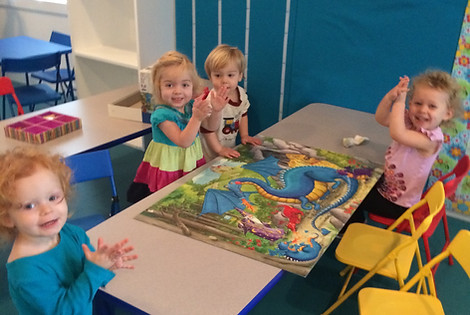top of page
A Child's Place LLC
Whole child development through play.
Certified Family Child Care CF504674
503-936-4676
4100 SE 72nd Ave, Portland, OR 97206
Sherree Tatum, owner & teacher
Remember:
-
Children want to be independent and will challenge themselves without pressure.
-
Offer the least help that will allow the child to succeed.
Introduction to puzzling for toddlers and preschoolers
There are many ways to set a child up for success with a puzzle.
-
The best puzzles have clear pictures with unambiguous shapes or patterns, and pieces that only fit together correctly.
-
Choose puzzles with a topic that is of interest to the child.
-
Do the puzzle first yourself. After, sort pieces and decide how best to set up the puzzle for your child's success.
-
For novice puzzlers or more complicated puzzles: Set out a few of the puzzles, arrange the puzzle pieces on the table, orient pieces correctly, and/or sort into pieces that go together.
-
Two or more kids with different abilities can puzzle together with some support: Ask one of the kids or the kids what part(s) they want to do. If there is disagreement then use "name sticks" or some other random way of choosing who goes first. It works best if you've sorted the puzzle into some kind of order. More info here.
-
Think about what you're thinking about as you put this puzzle together so you can "notice" when the child uses the same strategies.
-
First and most important, allow the child time to try without interference. Puzzles are fun! There is much to learn in doing and redoing a puzzle. Don't be surprised if your child is interested in putting the same puzzle together many, many times. It is a helpful lesson that practice makes a task easier. "Notice" that!

Initially, show two or three completed puzzles as if they were pages in a book. It's important to help kids focus on the picture of the puzzle rather than just on the shape of the pieces.
Engage: "What do you see? Look, this is the wizard. See the ... ."
Wait to allow the child time to look, think, touch, respond. Encourage the child to take one or more puzzles apart. After the child takes the puzzle(s) apart, again allow the child time to look, think, touch.
If the child seems stuck, wants interaction, seems to be getting frustrated or prepares to leave before completion, you can encourage the child to put the puzzle together. To engage the child try these strategies.
-
Prompt with words or gestures. For example, ask: "What part do you want to do?" "Which animal do you want to do first?" Pick up a piece, comment ("This looks like the baby bear") and put the piece in place. Wait.
-
Ask "Do you want to take turns trying a piece?"Do you want to pick first or second?" "Do you want to do the last piece?" Wait.
-
If you are a puzzler, think about the strategies you use to put a puzzle together. Notice when the child uses those strategies: "I see you are sorting the pieces." "That is another piece of the truck." "I see you found the other tire."
-
Think about what you find interesting in the picture or on a puzzle piece, then share that with the child. "I see a papa bear and a baby bear."
-
Do a puzzle yourself, talking through your process: "Turn all the pieces over." "Slide the piece then lift to put together." "What do I see?" "I'm looking at the picture on the box." "This piece looks like the tree on the edge of the picture." "I see the face and the shoes, so this must be the middle piece." "Where do the tires go?"
-
If the child chooses not to put the puzzle together let it go. Decide if you want to leave the puzzle out for the child to try again or put it away.
-
When it's time to put the puzzle away it's a good practice to expect the child to put away. A good strategy is to ask the child: "Do you want to put it away by yourself or do you want me to help?" Do you want to hold the bag or put the pieces in?"
-
If you do a puzzle then at the time to put away say: "I will also put away because I did a puzzle, too."
-
When putting more complicated puzzles away stack the puzzle pieces in some order the box and later hand out the pieces in sets.
-
After the puzzle is done, talk about the picture with the child.
-
Notice what the child did: "You kept trying until you got it done." "You put the hippo together first."
-
Share the pleasure of completing the puzzle.



bottom of page